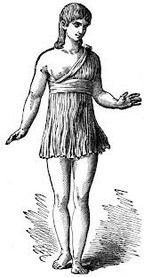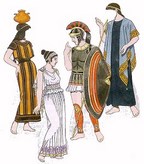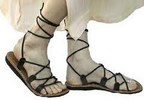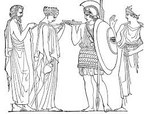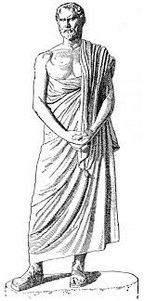The common clothes of the ancient Greeks were the chiton, the peplos, the himation and the chlamys. It’s wrong to believe that the ancient people were wearing only white clothes. Clothes existed in several colors and sometimes the colors and the style were indicating the social and the financial status of the person who wore them. The clothes of the ancient Greeks were easily sewed. Of course, the fashion and the habits changed depend on the historic periods and the local areas. For example, there was the Doric attire which was quite simple and the Ionic attire which had a lot of creases as an indication of wealth.
Wool, linen and leather were available for the Greeks to make their clothes. Silk was already known but it was very expensive so was a privilege only for the richest of the people and the monarchs. The imperialistic explorations of Alexander the Great imported cotton in Greece the . The ancient geographer, Pausanias, was the first who referred that there were cotton cultivations in the Greek area.
The ancient Greek fashion had a great influence on people out of Greece. For example, according to Plutarchus (Greek historian) Marcus Antonius, the Roman politician was a great lover of the Greek fashion of his time. Below, there is some more information about the ancient Greek clothing.
Chlamys
It was a short cloth of the ancient Greeks like a mantle and it was more decorative than necessary. At first it was weared by the Macedonians and the Thessalians and last by the Athenians. In Athens, the young people used to wear the chlamys until their adultness. It was made in many colors and fabrics. Hermes and Eros were two of the gods who were wearing chlamys.
Himation
Himation was worn over the chiton and was made of thick fabric with a similar use to our modern coat. Himation continued to be worn until the Byzantine years but then was a cloth for the poorer people.
Peplos
The woolen peplos was a feminine cloth and was wearing over the chiton. It was a squared shape fabric which was folded and held by buckles and cotter pins resulting an opening for the head and the neck.
Chiton
It was a basic type of clothing for both men and women and usually was made of linen. They were 2 kinds of chiton: the wide which was sewn on the upper side creating openings for the head or was closed with a line of small buckles. The narrow chiton was totally closed on the upper side (except the opening for the head) and had openings for the arms at the upper side of the two sides.
The ancient shoes
The shoes of the ancient Greeks were the following:
- The greaves: metallic or leather
- The ‘’closed’’ shoes
- The boots
- The sandals and the cothornus
The commonest were the sandals which were made of animal skin and had a plenty of cords. The rich Greeks were wearing leather sandals and is mentioned that politicians like Alcibiades and Ificrates created new fashion with their stylish sandals and that the slaves had to carry the shoes of their lords.
Beautification in ancient Greece
The ancient Greek women used creams to make their cheeks whiter , dyes for their eyebrows and cilia. We also know that in the lab of Pyron was creating a cream very rare and expensive, made of cinnabar. Many women had an entire lab for cosmetics with tweezers, pins, bottles with perfumes, creams containers wooden or earthen. For the make-up of the face and the lips they were using henna powder, berry juice, pencils or the roots of mallow. They made the eyebrows darker with smoke or grated antimony. For the hair, they used oil of cedar and bayberry to make them dark colored and flexible.
The ‘’Grecian’’ style clothes are still a great effect in the global fashion. A lot of famous designers created designs inspired by the ancient Greek clothes and they are specially loved by the modern women. If you come to Greece and you are interested about the fashion and its history, do not miss the opportunity to visit the Museum of History of the Greek Clothing which is located in Athens. It is a totally costume museum which includes in its collections over 25.000 pieces of the clothes and jewelry of the Ancient Greece which travels you back in time.
